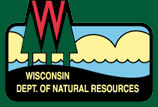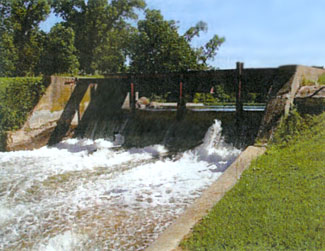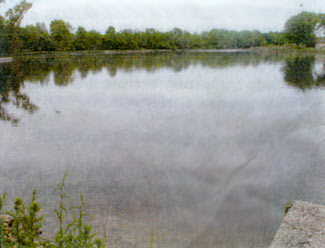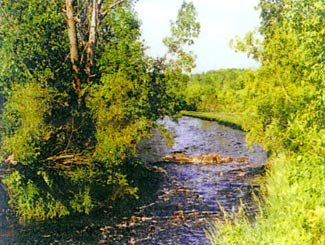Nemahbin Roller Mill Dam Abandonment Project
 Nemahbin Roller Mill Dam
Nemahbin Roller Mill DamAbandonment Project
FACT SHEET
 The Nemahbin Roller Mill Dam Abandonment Project will transform a twelve acre impoundment formed by the dam on the Bark River in Waukesha County into a free-flowing stream and natural floodplain. The abandonment is being done because the current dam is in a state of disrepair and it does not meet the dam safety standards as defined by Wisconsin State Statutes and Wisconsin Administrative Code. The eventual removal will improve the environmental health of the Bark River and eliminate a public safety hazard.
The Nemahbin Roller Mill Dam Abandonment Project will transform a twelve acre impoundment formed by the dam on the Bark River in Waukesha County into a free-flowing stream and natural floodplain. The abandonment is being done because the current dam is in a state of disrepair and it does not meet the dam safety standards as defined by Wisconsin State Statutes and Wisconsin Administrative Code. The eventual removal will improve the environmental health of the Bark River and eliminate a public safety hazard.
What About the Dam?
The Nemahbin Roller Mill Dam was originally an earthen and brush dam constructed around 1839. The dam was used to power a saw mill, and later a feed and flour mill.
In 1948 Ken and Margaret Zerwekh became the owners of the Nemahbin Roller Mill Dam. Mrs. Zerwekh is still the owner of the dam at this time. For more Upper Nemahbin history check out the history page.
Why is This Project Being Proposed?
There are regulatory and environmental reasons to abandon and remove the dam.
Regulatory: The current dam does not meet the dam safety standards as defined by NR333, Wisconsin Administrative Code. The dam is at the point where total reconstruction or removal are the only options.
The current dam owner applied for a permit to abandon the dam in 2004.
Environmental: When dams are constructed on
natural streams, the following often happen:
• water slows down and heats up
• the river is fragmented by the dam and
creates a barrier to fish movement
• nutrient-rich sediment settles at the pond bottom, covering rocks needed for bottom dwelling creatures and fish spawning.
• aquatic plants grow in thick mats
• dissolved oxygen levels rise sharply by day, and drop to critical levels by night
As a result of the changes that take place when a river is turned into a pond, the fish and wildlife found nearby change dramatically. For example, only the hardiest of fish and bottom dwelling species can survive the daily dissolved oxygen swings and warmer water temperatures.
When Will the Dam be Removed?
It is proposed that a slow drawdown of the impoundment will begin during the summer of 2008. This will expose some of the sediment and allow it to become stabilized before the actual removal process begins. The removal process will be initiated once the Department has received and approved plans and specifications for the removal. The timing of the dam removal will minimize disruption to aquatic life and will depend on river conditions.
How Will the Dam be Removed?
The Department has not yet received a site specific plan for the removal project. In a typical project, the initial step in removing the dam focuses on a slow drawdown to minimize recurring sedimentation downstream and allow the exposed mudflats to consolidate and revegetate. Heavy equipment is used to remove the entire concrete and metal portions of the structure. All or portions of the earthen embankment will be removed. Once the river has cut a new channel and the mudflats have stabilized, the stream channel and banks will revert to a natural condition.
What About the Exposed River Bank?
Due to the draw down of the impoundment area, portions of the riverbed will become exposed. As part of the removal project the contractor will be responsible for seeding the newly exposed riverbank to the extent possible. Typically, there is a substantial seed bank in impoundment sediments that will result in rapid growth of vegetation which will stabilize the exposed sediments.
How Will the Public Benefit?
Restoring this portion of the Bark River will improve the water quality and habitat for fish and wildlife species. Removal of the dam will eliminate a public health and safety hazard and provide the public with more opportunities to observe a diverse mix of wildlife and fish. There is limited recreational use of the millpond in its existing shallow condition. Removal of the dam will allow navigation by canoe and provide improved fishing opportunities. Over time, downstream sedimentation resulting from continuous flushing of the impoundment during high flow periods will be greatly reduced.

What is the Next Step?
The Department will accept comments on the project until July 3, 2008. Following the resolution of those comments and concerns, the Department will act on the abandonment application.
For More Information?
Brent Binder, PE
Wisconsin Department of Natural Resources
1155 Pilgrim Road
Plymouth, Wl 53073-4294
(920) 892-8756 ext. 3032
e-mail: brent.binder@wi.gov
